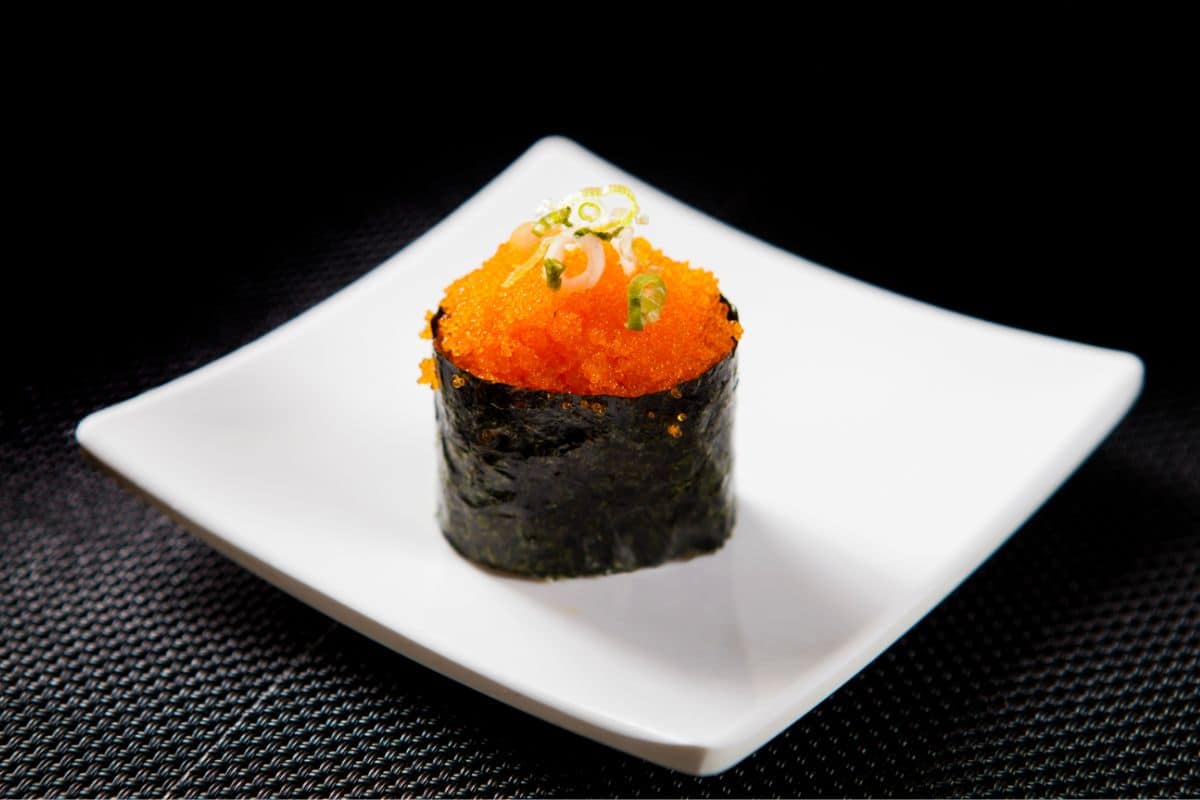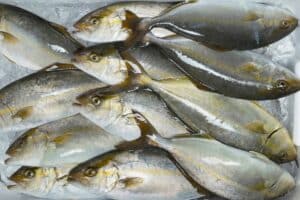If you’ve ever tried sushi before, whether it was as a pre-made snack from a grocery store or a bigger portion from a restaurant, there’s a high chance you will have tasted tobiko before, maybe without even realizing it.

This flying fish roe is commonly used in sushi dishes because of how effortlessly it manages to balance multiple very colorful and potent flavors all at once, adding a very refreshing and vibrant taste to any dish it’s added to.
Of course, tobiko doesn’t just need to be used as part of a sushi meal. You can just as easily keep it separate and use it to enhance a few other dishes instead, making it incredibly versatile.
Let’s take a deeper look at the flavor and texture of tobiko so that you can start thinking about what sorts of meals and recipes you could add it to down the line for everyone to enjoy.
What Actually Is Tobiko?
Tobiko is a type of fish roe (caviar) that is very recognizable because of its bright orange appearance.
The eggs look like small orange pearl-shaped blobs and actually have a very similar appearance to salmon roe, the only major difference being that the eggs are a lot smaller with tobiko.
Tobiko has easily been one of the most popular sushi ingredients in Japan for several decades, with it being seen as somewhat of a premium quality ingredient that many people will only enjoy on very rare occasions.
In this sense, it is very similar to caviar, being a rather expensive ingredient that many people consider a luxury to enjoy.
Over the last decade, tobiko has been much more prevalent in sushi dishes around the world, but it is always overshadowed by other ingredients, despite how crucial it is to the overall flavor, and especially the texture of sushi.
How Does Tobiko Taste?
Tobiko is most well known for having a flavor that perfectly balances being both sweet and salty, but on top of this, it also contains a very noticeable citrusy flavor, similar to orange zest.
This citrus taste becomes a lot less prominent when you actually come to eat it because once the tobiko is harvested, most producers will cure it with more salt in order to preserve it.
This can drown out the citrus so that it isn’t as strong or unpleasant, but you can definitely still notice it when taking a bite.
The most surprising part of tobiko is the texture, specifically the fact that it is incredibly crunchy.
Many people wouldn’t normally presume this when seeing the gooey appearance of the eggs, but the truth is, it is one of the only ingredients in sushi that contains this kind of crunchy and firm texture, which is why it is considered to be so essential.
The pearly eggs are also very robust and will hold their shape for much longer than many other types of fish eggs, which makes them ideal to use as a coating for sushi dishes and snacks.
What Food Tastes Similar To Tobiko?
Masago is very similar to tobiko in terms of texture, and partly in its flavor too, though it does tend to taste a lot more bitter than its counterpart.
Both ingredients share the same firm and crunchy texture however, and are often switched out for one another in many restaurants, especially because masago also tends to be a lot cheaper.
With that being said though, masago is much smaller in size and has a much less vibrant appearance than tobiko, which is a big reason why they tend not to work as well for sushi dishes which are prepared to look as appealing to customers as possible.
Ikura (salmon roe) is another very similar ingredient to tobiko, sharing a very bright reddish-orange color, and also being cured with salt when it is harvested.
The only major difference between the two is that ikura tends to taste slightly sweeter than tobiko, and the eggs are slightly bigger.
Nutritional Benefits Of Tobiko
Tobiko is an ingredient packed full of nutritional benefits, including being very rich in protein and omega-3 fatty acids.
It also contains an extremely high content of phospholipid fat which has been shown to protect the organs from inflammation.
It should be said however that tobiko is fairly high in cholesterol, which is a big reason why it is only enjoyed on rare occasions by many people, and also why its portion sizes tend to be very small.
However, when consumed in moderation, it’s still incredibly healthy.
Ways To Use Tobiko

Tobiko may have first found popularity by being used as an ingredient within sushi, but this doesn’t mean that it doesn’t also work as a delightful garnish to a few other dishes and meals too.
Here are 3 different ways you can use tobiko to help make a dish as flavorful as it can be, while also adding some much-needed crunchiness to the food too.
Salmon Mousse
A light and creamy salmon mousse can be made by using cream cheese, smoked salmon lox, and a drizzle of lemon juice to create a fluffy combination of ingredients that tastes as good as it sounds.
Simply blend this combination together in a food processor, and then either use the mixture as a dip, or lightly layer it on top of some cucumber slices or crackers.
Tobiko works incredibly well as the final garnish for this recipe because the eggs are small enough to rest over the top of the mixture, adding just a hint of crunchiness to help even out the airy tenderness of these small bite-size snacks.
Spicy Scallops
Cover some scallops with Japanese mayo and chili sauce, and you will immediately ramp up their spiciness, granting them a much more exciting and vibrant flavor that is complimented perfectly by the tobiko.
Not only does the flying fish roe help to enhance the crunchiness of these fiery snacks, but the sweetness also helps to make the chili combination a little more bearable by cutting it with its sweetness.
Tobiko Omelet
That’s right! Tobiko can be used as part of an omelet, and you won’t even need to alter the original recipe too much to include it.
Simply add in the tobiko eggs, along with a little bit of scallion, when the eggs are around 80% cooked, and they will immediately start mixing in with the extra ingredients to give you that delightful popping sensation each time you take a bite.
Summary
If you’ve ever been enjoying a plate of sushi and picked up on that slight citrusy flavor, along with the crunchy texture, then you will already have tasted tobiko.
But it’s still worth trying it out with other foods too if you enjoyed its sweet and salty flavor the first time around.






